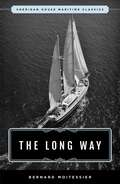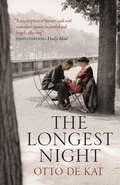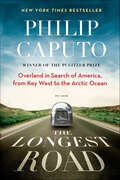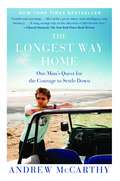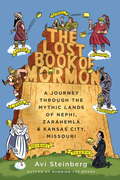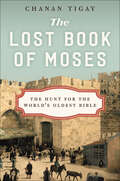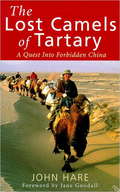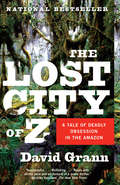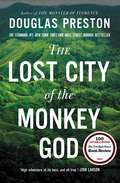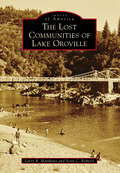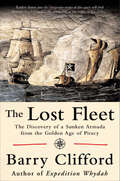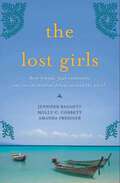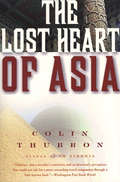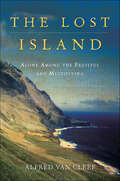- Table View
- List View
The Long Way: Sheridan House Maritime Classic (Maritime Classics)
by Bernard MoitessierThe Long Way is Bernard Moitessier's own incredible story of his participation in the first Golden Globe Race, a solo, non-stop circumnavigation rounding the three great Capes of Good Hope, Leeuwin, and the Horn. For seven months, the veteran seafarer battled storms, doldrums, gear-failures, knock-downs, as well as overwhelming fatigue and loneliness. Then, nearing the finish, Moitessier pulled out of the race and sailed on for another three months before ending his 37,455-mile journey in Tahiti. Not once had he touched land.
The Longest Night
by Otto de KatA masterpiece of literary craft and concision; sparse, beautiful and hugely affecting - Daily MailSince the liberation of the Netherlands, Emma Verweij has been living in Rotterdam, in a street which became a stronghold of friendships for its inhabitants during the Second World War. She marries Bruno, they have two sons, and she determines to block out the years she spent in Nazi Berlin during the war, with her first husband Carl. But now, ninety-six years old and on the eve of her death, long- forgotten memories crowd again into her consciousness, flashbacks of happier years, and the tragedy of the war, of Carl, of her father, and of the friends she has lost. In The Longest Night, his impressive, reflective new novel after News from Berlin, Otto de Kat deftly distils momentous events of 20th-century history into the lives of his characters. In Emma, the past and the present coincide in limpid fragments of rare, melancholy beauty.Translated from the Dutch by Laura Watkinson
The Longest Night
by Otto de KatA masterpiece of literary craft and concision; sparse, beautiful and hugely affecting - Daily MailSince the liberation of the Netherlands, Emma Verweij has been living in Rotterdam, in a street which became a stronghold of friendships for its inhabitants during the Second World War. She marries Bruno, they have two sons, and she determines to block out the years she spent in Nazi Berlin during the war, with her first husband Carl. But now, ninety-six years old and on the eve of her death, long- forgotten memories crowd again into her consciousness, flashbacks of happier years, and the tragedy of the war, of Carl, of her father, and of the friends she has lost. In The Longest Night, his impressive, reflective new novel after News from Berlin, Otto de Kat deftly distils momentous events of 20th-century history into the lives of his characters. In Emma, the past and the present coincide in limpid fragments of rare, melancholy beauty.Translated from the Dutch by Laura Watkinson
The Longest Road: Overland in Search of America, from Key West to the Arctic Ocean
by Philip CaputoIn The Longest Road, one of America's most respected writers takes an epic journey across America, Airstream in tow, and asks everyday Americans what unites and divides a country as endlessly diverse as it is large.Standing on a wind-scoured island off the Alaskan coast, Philip Caputo marveled that its Inupiat Eskimo schoolchildren pledge allegiance to the same flag as the children of Cuban immigrants in Key West, six thousand miles away. And a question began to take shape: How does the United States, peopled by every race on earth, remain united? Caputo resolved that one day he'd drive from the nation's southernmost point to the northernmost point reachable by road, talking to everyday Americans about their lives and asking how they would answer his question.So it was that in 2011, in an America more divided than in living memory, Caputo, his wife, and their two English setters made their way in a truck and classic trailer (hereafter known as "Fred" and "Ethel") from Key West, Florida, to Deadhorse, Alaska, covering 16,000 miles. He spoke to everyone from a West Virginia couple saving souls to a Native American shaman and taco entrepreneur. What he found is a story that will entertain and inspire readers as much as it informs them about the state of today's United States, the glue that holds us all together, and the conflicts that could cause us to pull apart.
The Longest Way Home: One Man's Quest for the Courage to Settle Down
by Andrew MccarthyWITH AN IRREPRESSIBLE TASTE for adventure, candor, and a vivid sense of place, award-winning travel writer and actor Andrew McCarthy takes us on a deeply personal journey played out amid some of the world's most evocative locales. Unable to commit to his fiancÉe of nearly four years--and with no clear understanding of what's holding him back--Andrew McCarthy finds himself at a crossroads, plagued by doubts that have clung to him for a lifetime. Something in his character has kept him always at a distance, preventing him from giving himself wholeheartedly to the woman he loves and from becoming the father that he knows his children deserve. So before he loses everything he cares about, Andrew sets out to look for answers. Hobbling up the treacherous slopes of Mt. Kilimanjaro, dodging gregarious passengers aboard an Amazonian riverboat, and trudging through dense Costa Rican rain forests--Andrew takes us on exotic trips to some of the world's most beautiful places, but his real journey is one of the spirit. On his soul-searching voyages, Andrew traces the path from his New Jersey roots, where acting saved his life--and early fame almost took it away--to his transformation into a leading travel writer. He faces the real costs of his early success and lays bare the evolving nature of his relationships with women. He explores a strained bond with his father, and how this complex dynamic shapes his own identity as a parent. Andrew charts his journey from ambivalence to confidence, from infidelity and recklessness to acceptance and a deeper understanding of the internal conflicts of his life. A gifted writer with an unsparing eye, Andrew relishes bizarre encounters with the characters whom he encounters, allowing them to challenge him in unexpected ways. He gets into peculiar, even dangerous situations that put him to the test--with mixed results. Disarmingly likable, Andrew is open, honest, and authentic on every page, and what emerges is an intimate memoir of self-discovery and an unforgettable love song to the woman who would be his wife.
The Longest Winter: Scott's Other Heroes
by Meredith HooperThrough the eyes of the men involved, Meredith Hooper recounts one of the greatest tales of adventure and endurance, which has often been overshadowed by the tragedy that befell Scott.Their tents were torn, their food was nearly finished, and the ship had failed to pick them up as planned. Gale-force winds blew, bitter with the cold of approaching winter. Stranded and desperate, Lieutenant Victor Campbell and his five companions faced disaster. They burrowed inside a snowdrift, digging an ice-cave with no room to stand upright, but space for six sleeping bags on the floor-the three officers on one side, the tree seamen on the other. Circumstances forced them closer together, their roles blurred, and a shared sense of reality emerged. This mutual suffering made them indivisible and somehow they made it through the longest winter.To the south, the men waiting at headquarters knew that Scott and his Polar party must be dead and hoped that another six lives would not be added to the death toll. Working from diaries, journals, and letters written by expedition members, Meredith Hooper tells the intensely human story of Scott's other expedition.
The Longevity Plan: Seven Life-Transforming Lessons from Ancient China
by Jane Ann Day John D. Day Matthew LaPlanteFrom a renowned Johns Hopkins- and Stanford-educated cardiologist at Intermountain Medical Center—a hospital system that President Obama has praised as an "island of excellence"—comes the story of his time living in Longevity Village in China, and the seven lessons he learned there that lead to a happy, healthy, long lifeAt forty-four, acclaimed cardiologist John Day was overweight and suffered from insomnia, degenerative joint disease, high blood pressure, and high cholesterol. On six medications and suffering constant aches, he needed to make a change. While lecturing in China, he’d heard about a remote mountainous region known as Longevity Village, a wellness Shangri-La free of heart disease, cancer, diabetes, obesity, dementia, depression, and insomnia, and where living past one hundred—in good health—is not uncommon.In the hope of understanding this incredible phenomenon, Day, a Mandarin speaker, decided to spend some time living in Longevity Village. He learned everything he could about this place and its people, and met its centenarians. His research revealed seven principles that work in tandem to create health, happiness, and longevity—rules he applied to his own life. Six months later, he’d lost thirty pounds, dropped one hundred points off his cholesterol and twenty-five points off his blood pressure, and was even cured of his acid reflux and insomnia. In 2014 he began a series of four-month support groups comprised of patients who worked together to apply the lessons of Longevity Village to their lives. Ninety-two percent of the participants were able to adhere to their plans and stay on pace to reach their health goals.Now Dr. Day shares his story and proven program to help you feel sharper, more motivated, productive, and pain-free. The Longevity Plan is not only a fascinating travelogue but also a practical, accessible, and groundbreaking guide to a better life.
The Lopapeysa Sweater: A Journey North in Search of Iceland's Iconic Knitwear
by Toni CarrEmbark on a journey through Iceland&’s most gorgeous landscapes and intimate traditions—straight from your armchair. The lopapeysa sweater is a treasured piece of Icelandic culture, knitted for generations, always gifted, never bought, with warmth and love in every stitch. From the breathtaking scenery, to the deep-rooted history, to the wisdom of the locals; Joan of Dark and Kyle Cassidywill be your guides as you read and knit your way through Iceland&’s culture, creativity, and lopapeysa tradition.In this knitter's guide to Iceland, join Joan and Kyle as they travel the 800 miles of Iceland&’s Ring Road to bring you historic sweaters, exciting adventures, and new knitting patterns. By interviewing local experts and digging through archives, they trace the historic beginnings of the &“lopi&” sweater and its legacy—and, of course, provide 12 new, original lopi-style patterns ranging from novice to advanced. No matter your knitting experience, you will be able to knit your way through these projects and enhance your look with style that is beautifully modern while still honoring the lopapeysa&’s rich history. We hope that this book will inspire you to visit Iceland with someone you love.
The Loss Of The Ship Essex, Sunk By A Whale
by Nathaniel Philbrick Thomas Philbrick Thomas Nickerson Owen ChaseThe gripping first-hand narrative of the whaling ship disaster that inspired Melville’s Moby-Dick and informed Nathaniel Philbrick’s monumental history, In the Heart of the Sea. In 1820, the Nantucket whaleship Essex was rammed by an angry sperm whale thousands of miles from home in the South Pacific. The Essex sank, leaving twenty crew members drifting in three small open boats for ninety days. Through drastic measures, eight men survived to reveal this astonishing tale. The Narrative of the Wreck of the Whaleship Essex, by Owen Chase, has long been the essential account of the Essex’s doomed voyage. But in 1980, a new account of the disaster was discovered, penned late in life by Thomas Nickerson, who had been the fifteen-year-old cabin boy of the ship. This discovery has vastly expanded and clarified the history of an event as grandiose in its time as the Titanic. This edition presents Nickerson’s never-before-published chronicle alongside Chase’s version. Also included are the most important other contemporary accounts of the incident, Melville’s notes in his copy of the Chase narrative, and journal entries by Emerson and Thoreau. .
The Lost Art of Reading Nature's Signs: Use Outdoor Clues To Find Your Way, Predict The Weather, Locate Water, Track Animals--and Other Forgotten Skills (Natural Navigation #0)
by Tristan GooleyTurn every walk into a game of detection—from master outdoorsman Tristan Gooley, New York Times-bestselling author of How to Read a Tree and The Natural Navigator When writer and navigator Tristan Gooley journeys outside, he sees a natural world filled with clues. The roots of a tree indicate the sun’s direction; the Big Dipper tells the time; a passing butterfly hints at the weather; a sand dune reveals prevailing wind; the scent of cinnamon suggests altitude; a budding flower points south. To help you understand nature as he does, Gooley shares more than 850 tips for forecasting, tracking, and more, gathered from decades spent walking the landscape around his home and around the world. Whether you’re walking in the country or city, along a coastline, or by night, this is the ultimate resource on what the land, sun, moon, stars, plants, animals, and clouds can reveal—if you only know how to look! #1 Bestseller in Star Gazing Publisher’s Note: The Lost Art of Reading Nature’s Signs was previously published in the UK under the title The Walker’s Guide to Outdoor Clues and Signs.
The Lost Book of Mormon
by Avi SteinbergIs the Book of Mormon the Great American Novel? Decades before Melville and Twain composed their great works, a farmhand and child seer named Joseph Smith unearthed a long-buried book from a haunted hill in western New York State that told of an epic history of ancient America, a story about a family that fled biblical Jerusalem and took a boat to the New World. Using his prophetic gift, Joseph translated the mysterious book into English and published it under the title The Book of Mormon. The book caused an immediate sensation, sparking anger and violence, boycotts and jealousy, curiosity and wonder, and launched Joseph on a wild, decades-long adventure across the American West. Today The Book of Mormon, one of the most widely circulating works of American literature, continues to cause controversy--which is why most of us know very little about the story it tells. Avi Steinberg wants to change that. A fascinated nonbeliever, Steinberg spent a year and a half on a personal quest, traveling the path laid out by Joseph's epic. Starting in Jerusalem, where The Book of Mormon opens with a bloody murder, Steinberg continued to the ruined Maya cities of Central America--the setting for most of the The Book of Mormon's ancient story--where he gallivanted with a boisterous bus tour of believers exploring Maya archaeological sites for evidence. From there the journey took him to upstate New York, where he participated in the true Book of Mormon musical, the annual Hill Cumorah Pageant. And finally Steinberg arrived at the center of the American continent, Jackson County, Missouri, the spot Smith identified as none other than the site of the Garden of Eden.Threaded through this quirky travelogue is an argument for taking The Book of Mormon seriously as a work of American imagination. Literate and funny, personal and provocative, the genre-bending The Lost Book of Mormon boldly explores our deeply human impulse to write bibles and discovers the abiding power of story.From the Hardcover edition. about us. And also an answer to the question: Why are we so afraid of the Book of Mormon? Literate and funny, personal and provocative, the genre-bending Lost Book of Mormon boldly explores our deeply human impulse to write bibles and discovers the abiding power of story.
The Lost Book of Moses: The Hunt for the World's Oldest Bible
by Chanan TigayA gripping account of one man’s quest to find the world’s oldest Bible and learn about the brilliant, doomed antiquities dealer accused of forging it.In 1883, Moses Wilhelm Shapira—archaeological treasure hunter, inveterate social climber, and denizen of Jerusalem’s bustling marketplace—arrived unannounced in London claiming to have discovered the world’s oldest Bible scroll in a desert cave east of the Dead Sea. With his phenomenal find, Shapira swiftly became world famous—but, just as quickly, his scroll was discredited as a clever forgery. With the discovery of the eerily similar Dead Sea Scrolls in 1947, however, investigators reopened the case, wondering whether Shapira had, in fact, discovered the first Dead Sea Scroll, seven decades before the rest. Here, in a globetrotting narrative with all the suspense of a classic detective story, award-winning journalist Chanan Tigay sets out to find the scrolls and determine Shapira’s guilt or innocence for himself.
The Lost Camels Of Tartary: A Quest into Forbidden China
by John HareJohn Hare has made three expeditions to the Mongolian and Chinese Gobi deserts, the first in 1993 with Russian scientists and the second and third with Chinese scientists in 1995 and 1996. The book records the amazing adventures he has experienced on those expeditions and will record details of the 30-day walk on foot in the formidable Kum Tagh sand dunes in the spring of 1997. He is the first recorded foreigner to have crossed the Gashun Gobi from north to south. The expeditions were primarily concerned with tracking down the mysterious wild Bactrian camel 'camelus bactrianus ferus' which lives in the heartland of the desert and is the ancestor of all domestic Bactrian stock. There are under a thousand left in the world and the wild Bactrian camel is more endangered than the giant Panda. This is John Hare's magnificent account of a formidable feat of modern exploration.
The Lost Camels Of Tartary: A Quest into Forbidden China
by John HareJohn Hare has made three expeditions to the Mongolian and Chinese Gobi deserts, the first in 1993 with Russian scientists and the second and third with Chinese scientists in 1995 and 1996. The book records the amazing adventures he has experienced on those expeditions and will record details of the 30-day walk on foot in the formidable Kum Tagh sand dunes in the spring of 1997. He is the first recorded foreigner to have crossed the Gashun Gobi from north to south. The expeditions were primarily concerned with tracking down the mysterious wild Bactrian camel 'camelus bactrianus ferus' which lives in the heartland of the desert and is the ancestor of all domestic Bactrian stock. There are under a thousand left in the world and the wild Bactrian camel is more endangered than the giant Panda. This is John Hare's magnificent account of a formidable feat of modern exploration.
The Lost City of Z: A Tale of Deadly Obsession in the Amazon (Vintage Departures Ser.)
by David Grann#1 NEW YORK TIMES BESTSELLER • From the author of Killers of the Flower Moon and The Wager comes a masterpiece of narrative nonfiction &“with all the pace and excitement of a movie thriller&”(The New York Times) that unravels the greatest exploration mystery of the twentieth century—the story of the legendary British explorer who ventured into the Amazon jungle in search of a fabled civilization and never returned. "[Grann is] one of the preeminent adventure and true-crime writers working today."—New York MagazineAfter stumbling upon a hidden trove of diaries, acclaimed writer David Grann set out to determine what happened to the British explorer Percy Fawcett and his quest for the Lost City of Z. For centuries Europeans believed the Amazon, the world&’s largest rain forest, concealed the glittering kingdom of El Dorado. Thousands had died looking for it, leaving many scientists convinced that the Amazon was truly inimical to humankind. In 1925 Fawcett ventured into the Amazon to find an ancient civilization, hoping to make one of the most important discoveries in history. Then he vanished. Over the years countless perished trying to find evidence of his party and the place he called &“The Lost City of Z.&” In this masterpiece, journalist David Grann interweaves the spellbinding stories of Fawcett&’s quest for &“Z&” and his own journey into the deadly jungle. Look for David Grann&’s latest bestselling book, The Wager!
The Lost City of the Monkey God: A True Story
by Douglas PrestonThe #1 New York Times and Wall Street Journal bestseller, named one of the best books of the year by The Boston Globe and National Geographic: acclaimed journalist Douglas Preston takes readers on a true adventure deep into the Honduran rainforest in this riveting narrative about the discovery of a lost civilization -- culminating in a stunning medical mystery.Since the days of conquistador Hernán Cortés, rumors have circulated about a lost city of immense wealth hidden somewhere in the Honduran interior, called the White City or the Lost City of the Monkey God. Indigenous tribes speak of ancestors who fled there to escape the Spanish invaders, and they warn that anyone who enters this sacred city will fall ill and die. In 1940, swashbuckling journalist Theodore Morde returned from the rainforest with hundreds of artifacts and an electrifying story of having found the Lost City of the Monkey God-but then committed suicide without revealing its location.Three quarters of a century later, bestselling author Doug Preston joined a team of scientists on a groundbreaking new quest. In 2012 he climbed aboard a rickety, single-engine plane carrying the machine that would change everything: lidar, a highly advanced, classified technology that could map the terrain under the densest rainforest canopy. In an unexplored valley ringed by steep mountains, that flight revealed the unmistakable image of a sprawling metropolis, tantalizing evidence of not just an undiscovered city but an enigmatic, lost civilization.Venturing into this raw, treacherous, but breathtakingly beautiful wilderness to confirm the discovery, Preston and the team battled torrential rains, quickmud, disease-carrying insects, jaguars, and deadly snakes. But it wasn't until they returned that tragedy struck: Preston and others found they had contracted in the ruins a horrifying, sometimes lethal-and incurable-disease.Suspenseful and shocking, filled with colorful history, hair-raising adventure, and dramatic twists of fortune, THE LOST CITY OF THE MONKEY GOD is the absolutely true, eyewitness account of one of the great discoveries of the twenty-first century.
The Lost Communities of Lake Oroville (Images of America)
by Larry R. Matthews Scott C. RobertsIn 1968, Lake Oroville flooded the West Branch, North Fork, Middle Fork, and South Fork canyons of the Feather River. Also inundated were the communities of Las Plumas, the Big Bend Power House, Bidwell Bar, and Enterprise. In 1994, Feather Falls Village, located above the lake, also ceased to exist due to a totally different situation. But all of these communities had one thing in common: there were people who had resided in them for decades and who still have an emotional connection to them. This book attempts to preserve some of the history of those areas and also tries to show some of what it was like to live in those now almost forgotten communities.
The Lost Continent
by Bill BrysonAn unsparing and hilarious account of one man's rediscovery of America and his search for the perfect small town.
The Lost Continent: Travels in Small-Town America
by Bill BrysonFrom the Publisher: An unsparing and hilarious account of one man's rediscovery of America and his search for the perfect small town.
The Lost Explorer
by David Roberts Conrad AnkerThis is the adventure story of the year -- how Conrad Anker found the body of George Mallory on Mount Everest, casting an entirely new light on the mystery of the explorer who may have conquered Everest seventy-five years ago. On June 8, 1924, George Leigh Mallory and Andrew "Sandy" Irvine were last seen climbing toward the summit of Mount Everest. Clouds soon closed around them, and they vanished into history. Ever since, mountaineers have wondered whether they reached the summit twenty-nine years before Edmund Hillary and Tenzing Norgay. On May 1, 1999, Conrad Anker, one of the world's strongest mountaineers, discovered Mallory's body lying facedown, frozen into the scree and naturally mummified at 27,000 feet on Everest's north face. The condition of the body, as well as the artifacts found with Mallory, including goggles, an altimeter, and a carefully wrapped bundle of personal letters, are important clues in determining his fate. Seventeen days later, Anker free-climbed the Second Step, a 90-foot sheer cliff that is the single hardest obstacle on the north ridge. The first expedition known to have conquered the Second Step, a Chinese team in 1975, had tied a ladder to the cliff, leaving unanswered the question of whether Mallory could have climbed it in 1924. Anker's climb was the first test since Mallory's of the cliff's true difficulty. In treacherous conditions, Anker led teammate Dave Hahn from the Second Step to the summit. Reflecting on the climb, Anker explains why he thinks Mallory and Irvine failed to make the summit, but at the same time, he expresses his awe at Mallory's achievement with the primitive equipment of the time. Stunningly handsome and charismatic, Mallory charmed everyone who met him during his lifetime and continues to fascinate mountaineers today. He was an able writer, a favorite of the Bloomsbury circle, and a climber of legendary gracefulness. The Lost Exploreris the remarkable story of this extraordinarily talented man and of the equally talented modern climber who spearheaded a discovery that may ultimately help solve the mystery of Mallory's disappearance.
The Lost Fleet: The Discovery of a Sunken Armada from the Golden Age of Piracy
by Barry CliffordAn explorer recounts historic events surrounding the sinking of a seventeenth-century, eighteen-ship French fleet, along with modern-day efforts to find it. On January 2, 1678, a fleet of French ships sank off the Venezuelan coast. This proved disastrous for French naval power in the region, and sparked the rise of a golden age of piracy. Tracing the lives of fabled pirates like the Chevalier de Grammont, Nikolaas Van Hoorn, Thomas Paine, and Jean Comte d&’Estrées, The Lost Fleet portrays a dark age, when the outcasts of European society formed a democracy of buccaneers, settling on a string of islands off the African coast. From there, the pirates haunted the world&’s oceans, wreaking havoc on the settlements along the Spanish mainland and—often enlisted by French and English governments—sacking ships, ports, and coastal towns. More than three hundred years later, writer, explorer, and deep-sea diver Barry Clifford follows the pirates&’ destructive wake back to Venezuela. With the help of a lost map, drawn by the captain of the lost French fleet, Clifford locates the site of the disaster and wreckage of the once-mighty armada.
The Lost Girls: Three Friends. Four Continents. One Unconventional Detour Around the World.
by Jennifer Baggett Holly C. Corbett Amanda PressnerThree friends, each on the brink of a quarter-life crisis, embark on a year-long backpacking adventure around the world in The Lost Girls.“A triumphant journey about losing yourself, finding yourself and coming home again. Hitch yourself to their ride: you’ll embark on a transformative journey of your own.” —New York Times bestselling author Allison Winn ScotchWith their thirtieth birthdays looming, Jennifer Baggett, Holly C. Corbett, and Amanda Pressner are feeling the pressure to hit certain milestones—score the big promotion, find a soul mate, have 2.2 kids. Instead, they make a pact to quit their high-pressure New York City media jobs and leave behind their friends, boyfriends, and everything familiar to set out on a journey in search of inspiration and direction.Traveling 60,000 miles across four continents, Jen, Holly, and Amanda push themselves far outside their comfort zones to embrace every adventure. Ultimately, theirs is a story of true friendship—a bond forged by sharing beds and backpacks, enduring exotic illnesses, trekking across mountains, and standing by one another through heartaches, whirlwind romances, and everything in the world in between. “A real-life fairy tale for anyone who’s ever wanted to chuck it all and see the world with a best friend on each arm.” —Cathy Alter, author of Up for Renewal“Three cheers to The Lost Girls for showing us, with good humor and graceful prose, the beauty and importance of leading life astray.” —New York Times bestselling author Franz Wisner
The Lost Heart of Asia
by Colin ThubronA land of enormous proportions, countless secrets, and incredible history, Central Asia was the heart of the great Mongol empire of Tamerlane and scene of Stalin's cruelest deportations. A remote and fascinating region in a constant state of transition-never more so than since the collapse of the Soviet Union-it encompasses terrain as diverse as the Kazakh steppes, the Karakum desert, and the Pamir mountains. In The Lost Heart of Asia, acclaimed, bestselling travel writer Colin Thubron carries readers on an extraordinary journey through this little understood, rarely visited, yet increasingly important corner of the world.
The Lost Island: Alone Among the Fruitful and Multiplying
by Alfred van CleefA striking narrative of a man's inadvertent discovery of the life force that persists in the most secluded of places--and isolated of beingsAfter the death of his father, Alfred Van Cleef--the last of a family of Dutch Jews--learns that he is unable to have children. Seeking the remotest spot on the planet, far from the gleefully reproducing couples of Amsterdam, Van Cleef picks a forbidding island in the Indian Ocean, a bizarrely bureaucratic French weather station, two thousand miles from the nearest continent. Finally entrenched on this lonely, wind-battered rock--following an eight-year odyssey to obtain a visiting permit and three weeks' rough passage--Van Cleef anticipates a total escape from the sexual frenzy of humanity: the island, ironically named Amsterdam, is inhabited solely by a group of thirty-six men. Yet this stark environment turns out to house a riotously mating society of albatrosses, sea elephants, fur seals--and especially bdelloid rotifers, an all-female species able to reproduce without males. It is in this unlikely setting that Van Cleef is forced to reckon with his most profound existential concerns.With wry humor and probing insight, Van Cleef weaves geography, natural history, and biology into The Lost Island, an original narrative of a lost island and a man, finally found.
The Lost Photographs Of Captain Scott: Unseen Images From The Legendary Antarctic Expedition
by Dr. David M. WilsonCaptain Scott perished with four of his fellow explorers on their return from the South Pole in March 1912. Almost immediately the myth was founded, based on Scott's diaries, turning him into an icon of courage in the face of impossible circumstances. But during the final months of that journey Scott also took a series of breathtaking photographs: panoramas of the continent, superb depictions of mountains and formations of ice and snow, and photographs of the explorers on the polar trail. But these photos have never been seen - initially fought over, neglected, then lost - until now, that is. For the first time, they are resurrected and are a humbling testament to the men whose graves still lie unmarked in the vastness of the Great Alone.
